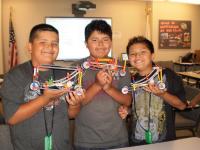- About
- Programs
- Broader Impacts and Engagement
- Partners & Grants
- Youth Impact Summit
- Contact Us
 Below you will find descriptions and links to a set of lessons designed to introduce students to concepts in the scientific method and sustainable engineering. Each curriculum is available as a downloadable .zip file and includes a lesson plan as well as a powerpoint presentation for use in the classroom. Some lessons also include worksheets, where applicable.
Below you will find descriptions and links to a set of lessons designed to introduce students to concepts in the scientific method and sustainable engineering. Each curriculum is available as a downloadable .zip file and includes a lesson plan as well as a powerpoint presentation for use in the classroom. Some lessons also include worksheets, where applicable. Electricity, Circuits, and Magnetism OH MY!
Overview: In this lesson, students are introduced to electricity and simple circuits. They will learn the definition of electricity and terms we use to describe the flow of electricity such as: voltage, current, and resistance. Students will learn about circuits in series and in parallel. Using the described equipment they will construct their own circuits. Finally, students will learn how simple electromagnetic motors work and be able to make their own simple motor. This activity is appropriate for grades 6th-9th.
Green Building Design Using Google SketchUp
Overview: Google SketchUp is a free software program that can be used to design a 3 dimensional “green” home. This lesson introduces students to the software and helps them build a simple structure from which they can add their own “green” additions. This lesson would be appropriate in a unit on energy conservation,
Oil Spill Clean-up: An Engineering Challenge
Overview: In this lesson students will review the BP oil spill and learn about current ways we are cleaning it up. They will test different methods that are currently being used in the gulf clean-up. After testing they will analyze the different methods and determine the most efficient way to clean up the oil spill. This activity is appropriate for grades 6th-8th.
Electrochemistry: Harnessing Electricity From Chemical Reactions
Overview: In this lesson, students review electricity and simple circuits. They will learn about connecting a circuit in series and in parallel. They will learn the definition of electrochemistry. They will be able to make a circuit and light up a small LED clock with potatoes, pennies and screws. This activity is appropriate for grades 6th-9th.

Nanocrystalline Solar Cell: Harnessing Light Energy
Overview: In this activity students will learn about solar cells and be able to construct their own nanocrystalline solar cell. They can then test and measure their cell’s electrical output. This activity starts with a review of photosynthesis and then discusses bio-mimicry. Engineers use solar cells to mimic photosynthesis. After a short discussion about the different types of solar cells, students are given instructions to create their own nanocrystalline solar cell. This activity is appropriate for high school science classes and requires a teacher who is familiar with chemical safety.
Harnessing Solar Power with K’nex Cars
Overview: In this lesson students will build K'nex rally cars and power them with solar panels. The students will design and build a K'nex car that can hold a solar panel and small motor. They will test their car and make improvements on their design. This lesson incorporates problem solving while teaching students about alternative forms of energy. This activity is appropriate for grades 6th-10th.
Speakers: Another Tool Using Magnetism And Electricity
Overview: In this activity, students will be designing their very own speakers out of basic materials that they can plug into any audio device that allows external speaker plug in (for amplification purposes, i.e. does not work with iPods, MP3 players, etcetera). This is a very important lesson in understanding the interaction of electromagnetic fields, magnets and coils of wire. This could be incorporated into a lesson on electricity, or sound. This lesson is recommended for grades 6th through high school.
Team Building and Critical Thinking Games
Overview: This kit includes four structured activities designed to teach critical thinking and team skills to students. Activities include group juggling, a "stepping stone" game, a group activity using drinking straws to build tall structures, and a problem solving activity where students try to figure out how to flip over a tarp while they are standing on it! Appropriate for grades 6-9.
There’s Oil in the Water: What is Pollution and What Can We Do About It?
Overview: This activity is designed to mock a water pollution story. In the story, a local river is polluted with oil. Students test water samples in an effort to find the pollution source. After the source is found, students brainstorm possible ways to keep the pollutant out of the water supply. They make a filter to absorb petroleum pollution from water. This activity should take about an hour and is appropriate to use with grades 5th through high school.
Harnessing Wind Power: Converting Mechanical Energy into Electricity
Overview: This lesson teaches students the basics of wind power and how it is generated. They are able to make their own wind blades, test them, and use the engineering process with specific design variables to improve their blade design. This activity would be appropriate to include in a unit on alternative energy, or in a unit on electromagnetism. This lesson could be in one block schedule class or two 50 minute periods. This activity is appropriate for 6th grade through high school.